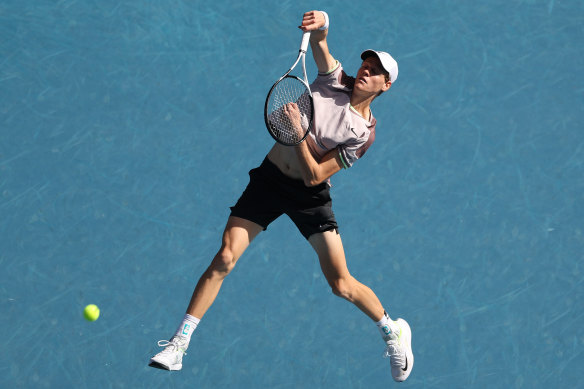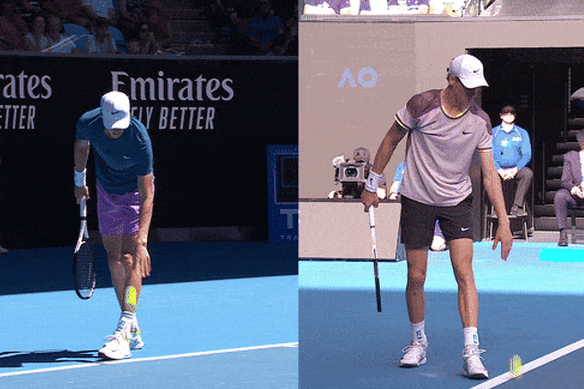- Analysis
- Sport
- Tennis
- Australian Open
This was published 2 months ago
AI analysed Jannik Sinner’s skeleton. This is what it found
By Scott Spits
The raw numbers tell plenty about the effectiveness of Jannik Sinner’s serve at the Australian Open, but sometimes it takes a vanquished opponent to best explain just why it’s become one of the Italian’s weapons of choice.
World No.1 Novak Djokovic’s six-year unbeaten streak at Melbourne Park had just ended at Sinner’s hands in dramatic centre court scenes late in the day session at Melbourne Park on Friday. Extraordinarily, the Italian world No.4 didn’t even offer up a single break point to Djokovic, undoubtedly one of the game’s best returners.

World No.4 Jannik Sinner.Credit: Getty Images
Djokovic was succinct when asked how Sinner, a player he’s now lost to in three of their past four clashes since November, had improved. The deceptively powerful Sinner earned praise for “smacking the ball really hard from both forehand and backhand corner”, but his serve, thanks to some subtle technical changes, didn’t escape mention.
“I think his serve improved a lot,” said 10-time Australian Open champion Djokovic. “He’s hitting his corners very well, and I think he [has upped] speed, as well.
“[He’s] serving bigger now and [it’s] more precise.”
Sinner has dropped serve just twice in six matches at Melbourne Park so far this tournament. He’s only lost one set, too – the third set on Friday when Djokovic did everything to stop the inevitable and forced a tie-breaker. The Italian’s only other tie-breaker came against Andrey Rublev in the quarters.
His tournament numbers tell a simple story. The percentage of service games won (98 per cent) is strikingly top of the tops among the men. Of those men’s singles players who went deep in the tournament, only Poland’s Hubert Hurkacz (91 per cent) and Rublev (also 91 per cent) are within range.
Sinner hasn’t had the highest first-serve percentage (60) but he’s ultra-effective when on-target, recording a return of 78 per cent on first serve points won. That’s not far behind the effectiveness of the big-serving Hurkacz (83 per cent).
What has been more closely observed by tennis insiders, however, is the slight change to Sinner’s service motion. Before our eyes at Melbourne Park this fortnight, those tweaks are bearing fruit.
As Tennis Australia’s head of innovation Machar Reid explains, it’s logical for a tennis professional to have an extra focus on fixing serving idiosyncrasies – simply because it’s one facet of the sport that the individual can directly affect.

The new-look Jannik Sinner serve: The 2023 version on the left, and the 2024 style on the right.Credit: Tennis Australia
“The serve in particular is the one shot in the game that you’ve got almost absolute control over,” said Reid. “It’s a closed skill.”
Data provided to this masthead about some of the world’s best men’s players shows how effective their serving has been. Figures generated for the players in the first three rounds from skeletal tracking technology – used for the first time in professional tennis at the Australian Open – for example, show that Sinner’s leg drive and fast-arm statistics have been particularly important.
Sinner rated high among the world’s best players for leg drive and was in second spot for his fast arm. Both elements are critical for generating and improving serve speed, Reid explains.
“In the important moment, he finds always a good first serve.”
Jannik Sinner’s coach, Simone Vagnozzi
“You can see that he’s transitioned from a foot-back service technique, to a foot-up service technique,” Reid said.
“When you do that, as a professional tennis player, it’s with a view to getting more vertical leg drive, and that helps in a number of different ways.”
Sinner’s leg drive was measured at 1.9 metres per second, behind Carlos Alcaraz (2.2m/s) and Holger Rune (2.1m/s) . Interestingly, Sinner upped the ante on Friday afternoon to 2.09m/s in his four-set destruction of Djokovic.
“When you’re stepping up with your back foot towards your front, you’re generating more leg drive,” said Reid.
“What that helps with, from a mechanical point of view, is that it stretches the muscles of your shoulder, kind of action-reaction if you like.
“The inertia of your racquet and upper arm means that the shoulder muscles stretch and that in turn allows you to internally rotate with your shoulder more aggressively.
“That ultimately adds speed to your serve.”
The new technology, a form of artificial intelligence, generates data from 12 cameras monitoring nearly 30 points on the skeleton to better understand player movement.
“The benefit for us, as a sport, is that we’re not so interested in that from an officiating point of view, but from a coaching point of view [and] allow groups to be that more precise in their feedback to players,” Reid said.
What has also been witnessed is Sinner’s greater ability to disguise his serve better – like a top bowler in cricket, for example, it pays dividends to keep your opponent in the dark for as long as possible.
Of the data generated on players such as Djokovic, Daniil Medvedev, Stefanos Tsitsipas and Australia’s Alex de Minaur, Sinner had the highest shoulder turn at 142 degrees.
“With slightly more shoulder turn, you’re able to disguise your serve more effectively,” Reid said.
“What we’re also observing this year with Sinner is that he’s got a more central ball toss, more at 12 o’clock as compared to further left, which is where he had it last year.
“That also assists with your trunk rotation and, particularly from a serve-speed point of view, that central ball toss will allow him to get a bit more pop on the serve.”
Technical changes take time and, much like 22-year-old Sinner’s career so far, the progression has been gradual.
“It is a really conscious decision that the coaching team will have made with a view to eliciting the types of performance effects we’re seeing this summer,” said Reid.
The Australian coach and highly respected tennis pundit is there to complement Sinner’s coach, Simone Vagnozzi.
“The whole team changed,” Cahill said after Friday’s ground-breaking semi win.
“We addressed everything ... I think he’d already been top 10 [in the world] before we started. You can’t be top 10 without having the platform of some incredible weapons, and he had those.
“I think the natural progression that Jannik needed to make everybody could see, but I think the coaching comes down to be able to give those messages in the right way, that he would believe in it, absorb it, and then do it on the practice court, [and] then eventually do it in matches – which is kind of what we’re seeing a little bit of now.”
Vagnozzi started working with Sinner earlier in 2022 and is delighted with how his charge’s serve has evolved.
“When we start, Jannik was, like Darren said, he was already unbelievable player. But I think [his style] was – how do you say in English? – monotony? Like when you play always the same,” Vagnozzi said.
“The serve I think improved a lot in the last two years ... I think [it] was probably one of the best [matches] ... for his serve today [against Djokovic] because the second set was amazing.
“In the important moment, he finds always a good first serve.”
Watch all the Australian Open action live on Nine, 9Gem, 9Now and ad-free on Stan Sport.
News, results and expert analysis from the weekend of sport sent every Monday. Sign up for our Sport newsletter.